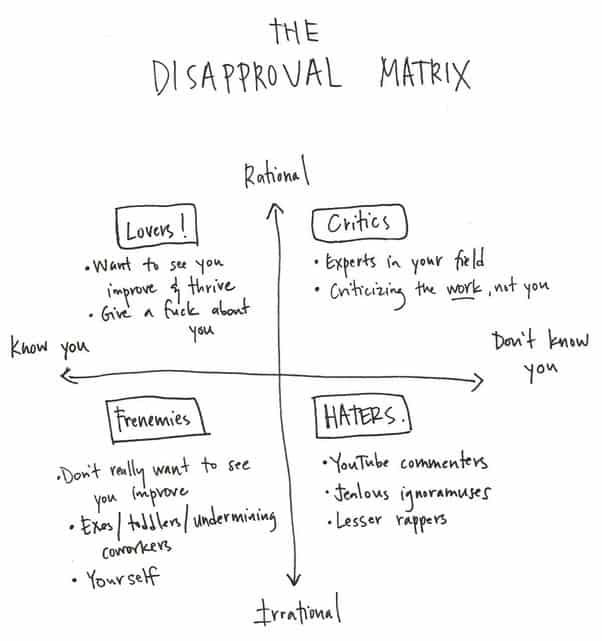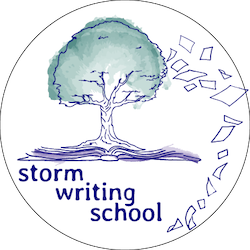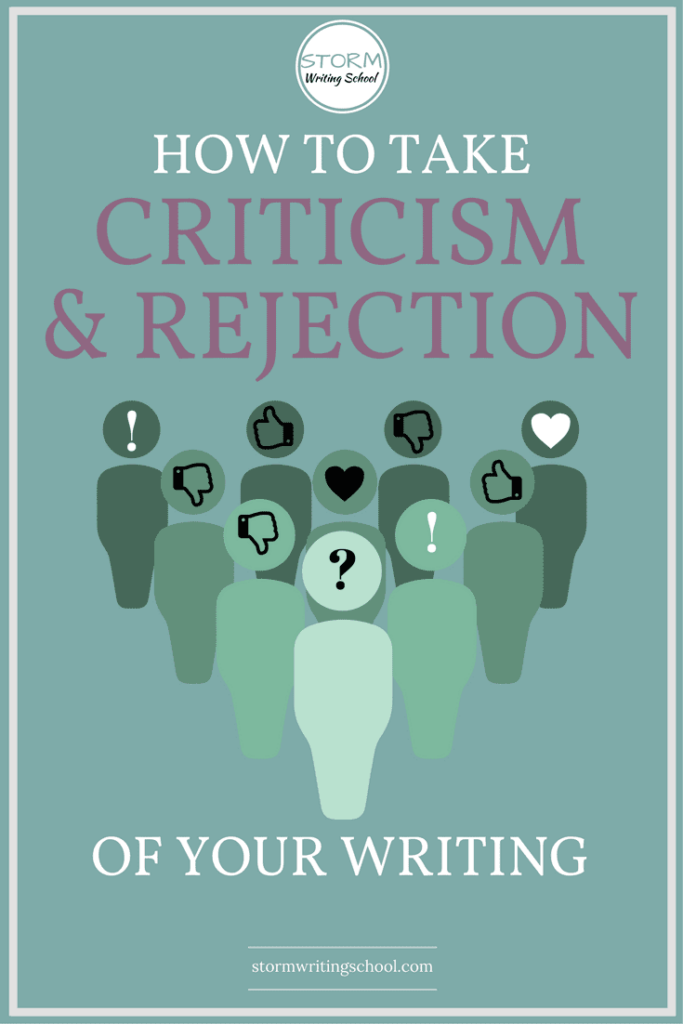I can really only speak for myself when it comes to handling criticism.
When it comes to issues of writing craft, I feel that I can speak for more than myself; I can speak for how others might receive your writing. I can tell you whether a scene has tension. I can tell you why it might lose readers. I can tell you what a dangling modifier is and why it will confuse people. I can talk about your transitions and your overall flow. I can explain the ins and outs of fluid narration and how to gain narrative authority. I can speak to all those things because language and storytelling are social, and because despite wide varieties of personal tastes, there’s a fair amount of consensus, actually, on what comprises effective communication and moving storytelling.
But your reaction to criticism and rejection is a little more idiosyncratic. So even though I’ll occasionally use the second person below, I’m not pretending to know what your particular reaction to particular people’s feedback on your particular piece should be.
Out of Mind
When I give my work to friends or colleagues and await a response, I feel a little nervous, sure, but by now, I’ve done it so often that I’ve become practiced at putting it out of my mind.
This is my trick for awaiting submission responses, too, by the way. Submit and forget. Don’t check the status on submittable. For the love of God, don’t query. Just put it out of your mind. Worrying about impending critiques has never helped anyone.
Find the Right Readers
I withhold reaction during a critique session. I take it, write down everything offered and take note of who said what. Later, when I’m looking over the notes, I’ll know the source. If, say, T. told me the scene at the dock felt flat, I’ll pay attention because T’s advice is always good. If J. told me the scene at the dock felt flat, I’ll maybe not put as much stock in it because J’s got weird taste and is always raving about how genius the Hangover films are.
Now, sometimes, especially if your piece is being read by a group of people, the advice you get will be contradictory and messy. Some people will seem to get it; others won’t. Some may even start to argue for why the piece fails. That’s always fun. How do you decide whose advice is best? You need to discriminate between the kinds of critics you face, and eventually, you need to trust your own instincts (more on that later).
Ann Freidman has come up with this brilliant “Disapproval Matrix.”

She explains each quadrant in her blog entry about this, but here’s her take-away:
The general rule of thumb? When you receive negative feedback that falls into one of the top two quadrants—from experts or people who care about you who are engaging with and rationally critiquing your work—you should probably take their comments to heart. When you receive negative feedback that falls into the bottom two quadrants, you should just let it roll off your back and just keep doin’ you.
I simply don’t give my writing to people in the lower two quadrants anymore (I mean, apart from myself). I feel very fortunate not to have to deal with the bottom dwellers. My various editors are all very capable. It took a while to get there, though. And I understand how you might be stuck with a group of writers who aren’t necessarily the best readers for you. I’ve been there.
Finding trusted readers is huge, though. As a writer, you need feedback. You need good readers who can give you sound advice because you’ll get to a point with your revisions where you can no longer be a good judge of your own work. You’ve just seen it too much.
Discouragement Is a Given
Even with trusted readers, though, I never really enjoy receiving criticism. Sure, I’ve had some readers mostly gush over work I’ve asked them to critique, but there’s always going to be follow-up work to do. And in fact, the better the piece is when you submit it for critique, the harder the changes you’ll be asked to make.
It’s not that I dread receiving critiques. But I prepare myself to be a little disheartened. I almost always come away from a critique a little discouraged at first. I just accept that I’ll have to go through the discouragement stage for a day or two before moving on.
In grad school, my most challenging advisor would rip my work to shreds (figuratively), and usually leave me feeling like I really sucked. I just didn’t have the time, though, to wallow in my discouragement because my next packet of work was due three weeks later. So I learned to allow a day of being down and then get to work.
Make a Revision Plan
What’s getting to work look like? I begin with a revision plan. I go through the piece, noting the general areas that need work and what kind of work they need. I don’t tackle the actual rewriting. There’s no doing; there’s only creating to-do lists. So I’ll end up with a list that looks like this:
1. The things without consequence need to have some consequence. (Bruce, the troll, escaping, the orchard)
2. Up the stakes as the story proceeds
3. Get more present-time story in the beginning before going to the flashback
4. Make Bruce more menacing
5. Stretch the tension in the orchard scene
As I’m doing this, I’ll sometimes come up with new ideas, so I jot those down, too:
6. Maybe: have the relationship between parents beginning to dissolve. Dad can’t handle mom being away; he discovers Seamus’ theft.
7. Maybe: show a daytime scene at the academy
I don’t rush my revision plan. For a short story, I mull it over for a couple days. For a novel, it would be weeks or a month. But I almost always find that 1) the revision plan is do-able. As intimidating as revision can be, I find I can always at least do the easier work of creating a to-do list. And 2) the revision plan always lifts me out of the post-critique discouragement. With a few exceptions, I suppose. If I’m being honest, I need to say that there are a few stories that, even after a revision plan, I determined just weren’t winners.
And that’s okay. You can let some go. Failure is the back door to success. So don’t sweat it. Just write the next thing.
If my story is something I know will be salvageable, however, revision planning is really the key to getting me to work on it.
Instincts
And then I revise.
It’s a cycle I’ve been through a lot. And it’s a very effective cycle, though, yes, it can require that you travel through an emotional valley or two. But the more I’ve gone through the cycle, the more capable I’ve become at editing my own work. You do the analytical work of revising enough and pretty soon, you find yourself having gut reactions to problems in your work. That is, before you can even analytically identify what’s wrong, you just feel that something is not quite working. That’s you developing your own instincts.
It may take several years before you get to the point where you can trust your own instincts, but persist and you will get there.
Submission Rejection
What about rejection?
Right. I just don’t even pay attention to rejection anymore. An acceptance rate of 5% is wonderful. That means the vast, vast majority of what you submit is going to be rejected. It’s not feedback, as this wonderful article explains:
The process of reading work for publication is not the process of reading to give feedback. When journal editors read, yes, they are evaluating the overall quality of the work. But they’re also asking, Does this fit our mission? Do I personally like it? Did we already accept something similar last week? They are assessing where the work fits in the overall structure of the magazine and its mission. A piece that isn’t the right fit must be let go, regardless of how good it is.
Coping with critiques and rejection is kind of the name of the game in the world of writing. Those who can weather it will succeed. Getting published is nice validation, but it’s not necessarily fun. The best source of joy in this strange avocation of ours is the satisfaction of knowing that you’ve written something you know is good.
- Looking for a trusted reader for your work? I might be able to help.
- And take a look at my course offerings to see whether anything there might help you begin to develop your instincts.
- Get indispensable craft tips in your inbox with my newsletter:
SaveSave
SaveSave
SaveSave
SaveSave
SaveSave
SaveSave
SaveSave
SaveSaveSaveSave
SaveSave
SaveSave









2 Responses